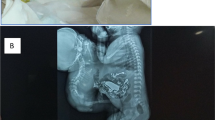Abstract
Parasitic twins can attach to the host at a number of different locations. The most usual variant is caudal duplication (dipygus), where the parasite consists of additional pelvic and lower limb structures attached to the pelvis of the dominant twin. Less commonly, the rudimentary twin can attach to the anterior thorax, the thoracic spine, or the epigastrium, as in this case. A 13-year-old boy was successfully managed and represents the eighth case of epigastric heteropagus reported, and the oldest presentation of such a case.
Similar content being viewed by others
References
Braun P, Addor C, Cuender A (1979) Surgical correction of caudal duplication. J Pediatr Surg 14: 561–563
Chadha R, Bagga D, Dhar A, Mohta A, Malhotra CJ, Taneja SB (1993) Epigastric heteropagus. J Pediatr Surg 28: 723–727
Chadha R, Bagga D, Malhotra CJ, Dhar A, Kumar A (1993) Accesoory limb attached to the back. J Pediatr Surg 28: 1615–1617
Chadha R, Dhar A, Bagga D, Malhotra CJ, Taneja SB (1993) An unusual form of caudal duplication (dipygus). J Pediatr Surg 28: 728–730
Hagberg S, Rubenson A, Lansinger O (1986) A case of surgically treated dipygus (caudal duplication). J Pediatr Surg 21: 58–59
Kamogawa KT (1991) A rare case of caudal duplication. J Pediatr Surg 26: 228–229
Mabogunje OA, Lowrie JH (1978) The heteropagus conjoined twins of NDU Sule, Nigeria. Clin Pediatr 17: 861–863
Nasta R, Scibilia G, Corrao A, Iacono M (1986) Surgical treatment of an asymmetric double monstrosity with esophageal atresia, omphalocele, and interventicular defect. J Pediatr Surg 21: 60–62
O'Neill JA Jr, Holcomb GW, III, Schnaufer L, Templeton JM Jr, Bishop HC, Duckett JW, Norwood WI, Ziegler MM, Everett-Koop C (1988) Surgical experience with thirteen conjoined twins. Ann Surg 208: 299–312
Pattabiraman C, Krishna A, Joseph SMJ (1986) Aborted thoracopagus. Ind J Pediatr 53: 531–533
Poradowska W, Jaworska M, Reszke S, Lodinski K (1969) Conjoined twins and twin parasite: clinical analysis of three examples. J Pediatr Surg 4: 688–693
Rowe MI, Ravitch MM, Ranniger K (1968) Operative correction of caudal duplication (dipygus). Surgery 63: 840–848
Simpson JS, Gibson DA, Cook GT (1973) Surgical correction of caudal duplication (dipygus). J Pediatr Surg 8: 935–938
Spitz L, Rickwood AMK, Pilling D (1979) Dipygus (caudal duplication). J Pediatr Surg 14: 557–560
Surendran N, Mani Nainan K, Paulose MO (1986) An unusual case of caudal duplication. J Pediatr Surg 21: 924–925
Takayanagi K (1991) A rare case of caudal duplication. J Pediatr Surg 26: 228–229
Author information
Authors and Affiliations
Rights and permissions
About this article
Cite this article
Saha, P.L., Dewan, P.A. Late presentation of epigastric heteropagus. Pediatr Surg Int 10, 432–433 (1995). https://doi.org/10.1007/BF00182252
Accepted:
Issue Date:
DOI: https://doi.org/10.1007/BF00182252




